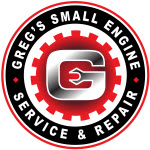Small engine repair can be one of the easiest — and cheapest — mechanical tasks you can perform yourself. Yet many people are intimidated by the idea, and not without good reason. People often assume that small engine repair is the same as auto repair, which can entail a complex system of gaskets, pistons and miscellaneous small parts that are better left to professional experts.
The good news is that small engine repair is nowhere near as complex as you might think. We won’t lie, it will take a certain amount of both trial and error, and more than a little elbow grease, to pinpoint fix a small engine yourself. But once you know what you’re looking for, some types of repair can be surprisingly easy. For some people, performing these types of simple repairs can even be enjoyable. If you’ve ever wondered what you need to know about small engine repair and maintenance, we’ll help you troubleshoot some of the more common problems you may run into.
Is It The Carburetor?
There are three types of carburetors most commonly used in small engines: downdraft, natural draft and updraft. The names basically describe the direction of how fuel and air combine in your engine. In order for your small engine to run smoothly, you need to make certain both the speed and the ar/fuel mixture are properly aligned. For the following steps, please review your operator’s manual to find where both needles are located:
- Step 1: While letting the engine run, open the throttle as wide as you can. Slowly tune the high speed adjustment needle back and forth until you find the highest speed setting.
- Step 2: Turn the throttle to the slowest running speed. There’s a separate idle speed needle. Adjust it until you find the recommended idle speed listed in your manual.
- Step 3: Once you’ve found the idle speed, adjust the mixture until your small engine operates smoothly.
Is It The Spark Plug?
This may seem like a punchline to an old joke. It isn’t. A spark plug needs to be able to withstand high temperature heat and countless ignitions throughout the course of its lifetime, and it’s critical to the maintenance of a small engine. Luckily, here is a very simple way to service a spark plug:
- Step 1: At the top of the plug, disconnect your lead wire.
- Step 2: Loosen the plug from the cylinder (always use a spark plug wrench!) Clean any debris and gunk you may find at the base.
- Step 3: Remove the spark plug and examine it. Is there excessive build-up? If so, it simply needs to be cleaned. If it appears damaged, then it needs to be replaced.
- Step 4: Examine the electrode. If it appears to be damaged, this also will need to be replaced.
- Step 5: Assuming there is no damage, clean the surface of the plug using a soft cloth and the electrode with a spark plug cleaning device. If you don’t have one, a wire brush will typically suffice.
- Step 6: With a feeler gauge, set the gap on the electrode back to the recommendations in your owner’s manual.
Is It The Flywheel?
Make sure you detach the lead from your spark plug first before following these steps:
- Step 1: Rotate your flywheel by hand. Look for any unbalanced movement or damage. If there is damage, it will need to be replaced. If it’s just a little wobbly, you’re in luck.
- Step 2: Using a puller, remove the flywheel from the crankshaft.
- Step 3: With a dust cloth, simply clean your flywheel’s surface and reattach.
Is It The Engine Itself?
One of the most common problems with two-stroke engines isn’t a malfunction. It’s lack of proper lubrication. This can easily be remedied by using a simple mixture of lubricating oil and gasoline. Your operator’s manual will contain information about the specific grade and ratio of oil to fuel. At all costs, avoid ethanol gasoline, which actually absorbs water and will corrode your small engine rapidly. Before mixing, make absolutely certain you’re using a vented gas canister expressly for the purpose of mixing gasoline.
- Step 1: Using the manual’s recommendation, add the correct amount of oil to the gasoline in the can. A few things to keep in mind: a gallon consists of 128 fluid ounces. A fuel-oil ratio of 50:1, for example, indicates one ounce of oil added for every 50 ounces of fuel. A fuel-oil ratio of 25:1 (more common in smaller engines) means five ounces of oil added for each gallon of fuel.
- Step 2: Making sure the cap is securely fastened, shake the fuel-oil mixture vigorously and pour it into your fuel tank slowly and carefully.
- Step 3: Rotate your fuel tank several times to ensure that it’s blended thoroughly.
Is It The Air Cooling System?
Cooling fins around the air cylinder tend to get clogged up easily after frequent use. Luckily, it’s just as easy to clean them:
- Step 1: After removing the cover from around the engine flywheel, inspect the system for debris. Generally speaking, it’s a good idea to do this periodically even if your engine is running smoothly as a preventative measure.
- Step 2: Using a paintbrush, clean any debris from the cylinder head.
- Step 3: Wipe down the surfaces of the cooling fins, cylinder and cylinder head with a damp cloth. It’s important that the engine has cooled down entirely.
- Step 4: Replace the cover over the cylinder and flywheel, making certain the blades aren’t striking against it.
Other Common Problems With Small Engines
- If there’s no voltage at the spark plug, check the coil, condenser and leads. If there’s any damage, replace your spark plug immediately.
- If your throttle won’t open, set it to the FAST or RUN positions. Check for any binding or disconnected linkage.
- If your engine is running too hot, clean the cooling fins as recommended above. It can also be a result of a low oil level.
- Check your belts, chains and shafts if a driven device moves slowly or not at all. If there is any damage, replace them immediately.
- Lubricate or replace blades and tines as necessary if you find they’re not cutting properly. They may also need sharpening either from a blade-specific sharpening unit or a professional service.
- Water in your fuel system is a common cause of a poorly functioning small engine. Drain your carburetor, fuel and tank lines and replace it with the recommended fuel-oil mixture.
- If none of the above work, contact a professional repair and maintenance service.
Still need help with your small engine repair? At Greg’s Small Engine, we provide service and repairs throughout the Reno and Carson City area 7 days a week, with pickup and delivery options for your convenience. Find out more at Greg’s Small Engine.






















